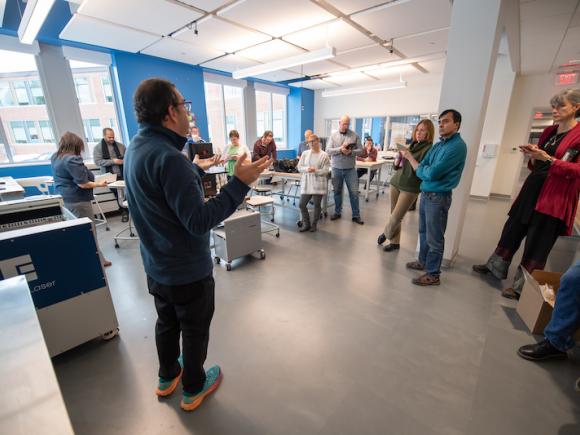
Research, Innovation, Design, & Entrepreneurial Center Hosts Faculty in Technology Workshop

Faculty and staff gathering as part of the two-day workshop.
The Research, Innovation, Design, & Entrepreneurial (RIDE) Center in Parenzo Hall recently presented a workshop aimed at making faculty aware of the technology available in the newly formed facility. Hosted by RIDE Executive Director Lamis Jarvinen, and Anna Young and Jose Gomez-Marquez of MakerHealth, University faculty members toured the Center and learned how to use 3-D printers, laser cutters, and microcontrollers. MakerHealth specializes in the training of professionals on how to better implement technology in the workplace.
ãWhat we're really talking about is accessibility,ã Jarvinen said. ãMy goal is to develop a center for every single student that walks on our campus to go through and be exposed to problem solving, working as teams, fabrication, and design technology.ã
Because Jarvinen was instrumental in the development of the RIDE Center, one question she kept in mind while aiding in its planning was, ãHow do we create opportunities for applied experiences?ã
Part of this was rooted in the student experience at 91äØè¨ State. ãIt made me realize that students come into the classroom, and they may have a lot of content knowledge, but they really don't have a good understanding of how that content really applies in real life situations,ã she said. ãI want students and users to know that their perspective, their experiences, their knowledge, is really important to have them at the design table. It shouldn't just be engineers, for example, who are coming up with ideas. I think that all of us can do these things if we're given the tools and the ability to be able to try something, fail, and learn from it.ã
Additionally, while the RIDE Center is an environment rich with academic lessons and opportunities, students who utilize the Center will also hone real-world skills such as critical thinking and problem solving. ãWhat we're doing is creating this culture of problem solvers and perspective takers and thought leaders.ã Jarvinen added. ãI think there's a level of confidence that comes out of being able to solve a problem in your way that speaks to you. I think that's what's so amazing about the RIDE center.ã
To showcase this philosophy, Jarvinen, Young, and Gomez-Marquez spent the first day of RIDE workshops introducing the Centerãs technology to faculty members, as well as doing demos with some of the equipment for a more hands-on experience.
Afterwards, faculty filled out worksheets provided by the instructors detailing what they personally wish for the Center to accomplish, answering questions such as: How do you see yourself using this space? How do you see your students using this space? What tools are you interested in using?


On the second day, both the instructors and faculty talked through the results, and brainstormed on how to demystify the utilization of the Centerãs resources. ãThe workshops were very successful,ã Jarvinen said. ãWe had 12 faculty members from all different disciplines, and they were excited to be there. I feel that the Center has a community feel to it, and I think that's something people arenãt really aware of.ã
ãThe RIDE Center shows how open prototyping and design tools have a wonderful and imaginative place at a liberal arts universityãs teaching and research opportunities,ã Anna Young said. ãOver the two-day workshop, we worked with faculty from all parts of campus. From mathematicians working on 3-D printing complicated calculus functions, to environmental scientists printing pollen models, and physics faculty working to design hands-on instruments for first year lectures. We brainstormed with macroeconomists on the teachable implications when labor economics meets digital fabrication and discovered amazing perspectives on how to use maker tools to teach history and material culture. 91äØè¨ State has new tools for the campus. Our enthusiasm is on the energy they are stirring from faculty to generate experiential learning models for everyone.ã
Subramanian Vaitheeswaran, Assistant Professor of Chemical and Physical Sciences at 91äØè¨ State, described feeling ãexcitedã by the new tools, as he believes they will ãenhance our studentsã education in ways we didnãt even dream ofã. He plans to bring students from his laboratory courses to the RIDE Center to bolster their understanding of course lessons and materials.
For those in other departments, connecting the Centerãs technology to their own classes was initially difficult. ãIn our field, we don't ãproduceã anything and the only models we look at are graphical,ã Susanne Chuku, Associate Professor of Economics said. ãProduction or profit functions are more in the microeconomics field, and so I was wondering how this space can inspire our major as well.ã However, when leaving the two-day workshop, Chuku said that she left with several ideas on how to incorporate its technology into her classes regardless of her initial concerns.
Charles DiStefano, Assistant Professor of Political Science, Christine Von Renesse, Professor of Mathematics, and James Ramsay, Assistant Professor of Biology, likewise have already integrated the Centerãs machines with class lessons intended to provide hands-on experience and help actualize theories or practices studied in the classroom.
Now, Jarvinen, Young, and Gomez-Marquez will assess the next steps to take when making sure that everyone has access to being trained in using the Centerãs equipment. On its website, people will soon be able to sign up for training, though itãs still being designed.
ãItãs all about innovation,ã Jarvinen said. ãIt starts with one person's issues that then impact a whole community. I want it to be a very active space. So, the more people are in there, I think the more light bulbs will go on.ã


